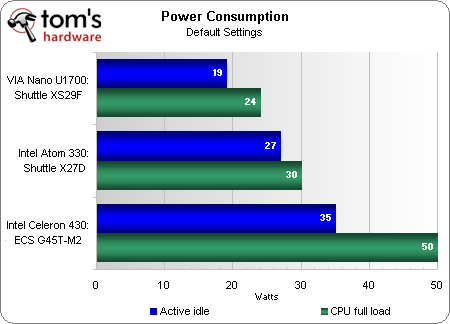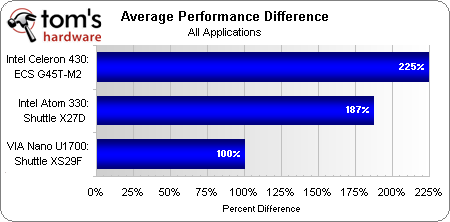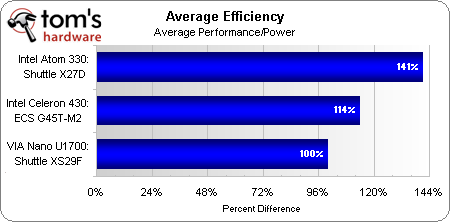Shuttle XS29F: Is VIA's Nano Processor Powerful Enough?
Power And Efficiency
VIA’s claim to processor fame is probably the low advertised power draw, which has allowed several generations of product to operate without need of a cooling fan. On the other hand, efficiency is a measure of units of work per units of power, where weak performance can effectively cancel out any power savings. Is the Nano U1700 really a efficient as VIA claims?
Shuttle’s Intel dual-core platform drew only 33% more power than its single-core Nano solution. But besides having twice as many cores, the Atom is clocked higher. Will the Atom exceed the Nano’s performance level by more than 33%?
Indeed, the dual-core Atom performed 87% better on average than the Nano, even though only one out of five benchmark sets appeared to be dual-core optimized. We’ll probably have to wait for a 1.60 GHz dual-core Nano before we see VIA provide any real competition to Intel’s Atom 330.
The Atom slaughters the Nano in efficiency, in spite of VIA’s high-efficiency claims and low power consumption, and in spite of the ancient power-hungry 945GC chipset used in Shuttle’s Atom system. Even the microATX Celeron system, with its full expansion capability and 35W TDP processor, took a tiny lead over the Nano in efficiency.
Get Tom's Hardware's best news and in-depth reviews, straight to your inbox.
-
Wouldn't this just be a linux-only machine then? I can't possibly see any other use for it other than maybe a childs pc or a general "Internet & Email only" PC.Reply
-
pakardbell486dx2 This may be a dumb question, but why was Xp not used for this test? Clearly "just barely" wont work for people who spend their hard earn money on something like this. Maybe the celeron is ok for vista basic but the atom and nano platforms are just not good enough for Vista. If I can make an analogy comparing Vista and Atom/Nano it's like an old 73' Corolla trying to haul ten tons uphill.Reply -
tacoslave amd huron platform thats all i have to say i want to see it benched see how it stakes up.Reply -
Blueridge I agree that the major drawback of this review is the use of Microsoft Vista. I think that Windows XP Home edition for ULPC or a netbook spin of a linux distro (e.g. Ubuntu) would have been a much better choice for this review, especialy since is very well known that Vista is just not the right choice for netbooks (or nettops). Some time ago I read several reviews of the nano processor, based on Win XP and they performed more than OK, they were even suitable for a small HTPC at that time (the toughest challenge was DVD playback back then) and with a better chipset would have performed even netter. But this happens when a resource hungry OS like vista is used... just my 2 cents.Reply -
HalfHuman i guess a windoze xp or 7 would be a lot better to use with this kind of hardware. in fact i cannot think at a more inapropriate os to run on a nentop than vista. :)Reply
maybe the performance delta would be the same but the usability would be more than "acceptable".
regarding the "benchmarking" stuff... i do not think that anybody sane would buy a nettop to use it for hardcore photo editiing or transcoding.
if i'd buy a nettop i'd be interested in several factors:
- to be powerfull enough for office work and maybe hd playback
- to use as little power as possible (which nano does nicely) as this kind of device would be rarely powered down
- to be silent (which nano is)
i think that performance per watt is irrelevant here as a system like this is not meant to be "performant". i think that the one that uses less watts, has more features is queter wins here.
my take on this is that via has a very nice platform and nano wins even if it's not the fastest. -
Blueridge I just took a look at Via's website and it seems that Nano is available in flavors up to 1.8GHz. I wish a machine based on such a processor was used for this review, though I think the main issue here is availability.Reply -
HalfHuman i would be nice to see some noise evaluations, some hd playback tests... some appropriate os. :)Reply -
eddieroolz The Nano would be the perfect computer to just leave it powered on, seeding torrents and such.Reply



